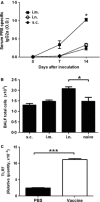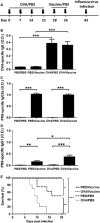Inactivated influenza virus vaccine is efficient and reduces IL-4 and IL-6 in allergic asthma mice
- PMID: 24010941
- PMCID: PMC4634242
- DOI: 10.1111/irv.12150
Inactivated influenza virus vaccine is efficient and reduces IL-4 and IL-6 in allergic asthma mice
Abstract
Background: Allergic asthma is a globally respiratory inflammatory disease. Influenza virus is a respiratory pathogen that causes yearly epidemics and results in high rates of morbidity and mortality. Patients with allergic asthma had a more severe symptom and a higher mortality when they were infected with influenza virus. Hence, influenza vaccination is recommended for patients with asthma.
Objectives: We evaluated the efficacy and effects of influenza vaccination on allergic asthma in a mouse model.
Methods: Ovalbumin-immunized mice were inoculated with inactivated influenza virus A/Puerto Rico/8/34 (PR8) as vaccines and morbidity or mortality and allergic asthma features of these mice were analyzed.
Results: Mice inoculated with inactivated PR8 induced high levels of anti-PR8 IgG2a and upregulation of Toll-like receptor (TLR) 7. Vaccinated allergic mice were healthy when they were challenged with live influenza virus while none of non-vaccinated allergic mice survived. Furthermore, inactivated influenza virus vaccine induced neither extra airway inflammation nor asthma features such as IgE, airway hyper-reactivity, and eosinophilia in allergic mice. Particularly, decreased frequency of immune cell infiltrated airways and Th2 cytokines IL-4 and IL-6 production in the bronchoalveolar lavage fluid were noted in vaccinated allergic mice. These results suggested that inactivated influenza virus vaccine is efficient to protect allergic mice from further influenza infection, and it does not exacerbate but reduces IL-4 and IL-6 of allergic asthma.
Conclusion: Influenza vaccination is essential and efficient for allergic subjects to protect influenza virus infection.
Keywords: IL-4; IL-6; PR8; asthma; vaccine.
© 2013 John Wiley & Sons Ltd.
Figures





Similar articles
-
Evaluation of the influenza vaccine protection in the house dust mite-induced chronic allergic asthma mice model and the evaluation of squalene oil in water emulsion as an adjuvant candidate.Respir Res. 2025 Apr 10;26(1):132. doi: 10.1186/s12931-025-03209-6. Respir Res. 2025. PMID: 40205548 Free PMC article.
-
Intranasal delivery of whole influenza vaccine prevents subsequent allergen-induced sensitization and airway hyper-reactivity in mice.Clin Exp Allergy. 2007 Aug;37(8):1250-8. doi: 10.1111/j.1365-2222.2007.02767.x. Clin Exp Allergy. 2007. PMID: 17651156
-
Protective efficacy of a bivalent inactivated reassortant H1N1 influenza virus vaccine against European avian-like and classical swine influenza H1N1 viruses in mice.Vet Microbiol. 2020 Jul;246:108724. doi: 10.1016/j.vetmic.2020.108724. Epub 2020 May 19. Vet Microbiol. 2020. PMID: 32605742
-
A Replication-Defective Influenza Virus Harboring H5 and H7 Hemagglutinins Provides Protection against H5N1 and H7N9 Infection in Mice.J Virol. 2021 Jan 13;95(3):e02154-20. doi: 10.1128/JVI.02154-20. Print 2021 Jan 13. J Virol. 2021. PMID: 33177192 Free PMC article.
-
Influenza virus: immunity and vaccination strategies. Comparison of the immune response to inactivated and live, attenuated influenza vaccines.Scand J Immunol. 2004 Jan;59(1):1-15. doi: 10.1111/j.0300-9475.2004.01382.x. Scand J Immunol. 2004. PMID: 14723616 Review.
Cited by
-
Evaluation of the influenza vaccine protection in the house dust mite-induced chronic allergic asthma mice model and the evaluation of squalene oil in water emulsion as an adjuvant candidate.Respir Res. 2025 Apr 10;26(1):132. doi: 10.1186/s12931-025-03209-6. Respir Res. 2025. PMID: 40205548 Free PMC article.
-
An Adenovirus-Vectored Influenza Vaccine Induces Durable Cross-Protective Hemagglutinin Stalk Antibody Responses in Mice.Viruses. 2017 Aug 21;9(8):234. doi: 10.3390/v9080234. Viruses. 2017. PMID: 28825679 Free PMC article.
-
Screening of Bioactive Fraction of Radix Paeoniae Alba and Enhancing Anti-Allergic Asthma by Stir-Frying Through Regulating PI3K/AKT Signaling Pathway.Front Pharmacol. 2022 Mar 31;13:863403. doi: 10.3389/fphar.2022.863403. eCollection 2022. Front Pharmacol. 2022. PMID: 35431951 Free PMC article.
-
Influenza in High-Risk Hosts-Lessons Learned from Animal Models.Cold Spring Harb Perspect Med. 2020 Dec 1;10(12):a038604. doi: 10.1101/cshperspect.a038604. Cold Spring Harb Perspect Med. 2020. PMID: 31871227 Free PMC article. Review.
-
MAIT cells are activated during human viral infections.Nat Commun. 2016 Jun 23;7:11653. doi: 10.1038/ncomms11653. Nat Commun. 2016. PMID: 27337592 Free PMC article.
References
-
- Holgate ST, Polosa R. Treatment strategies for allergy and asthma. Nat Rev Immunol 2008; 8:218–230. - PubMed
-
- Chuang YH, Yang YH, Wu SJ, Chiang BL. Gene therapy for allergic diseases. Curr Gene Ther 2009; 9:185–191. - PubMed
-
- Ong BA, Forester J, Fallot A. Does influenza vaccination improve pediatric asthma outcomes? J Asthma 2009; 46:477–480. - PubMed
MeSH terms
Substances
LinkOut - more resources
Full Text Sources
Other Literature Sources
Medical

